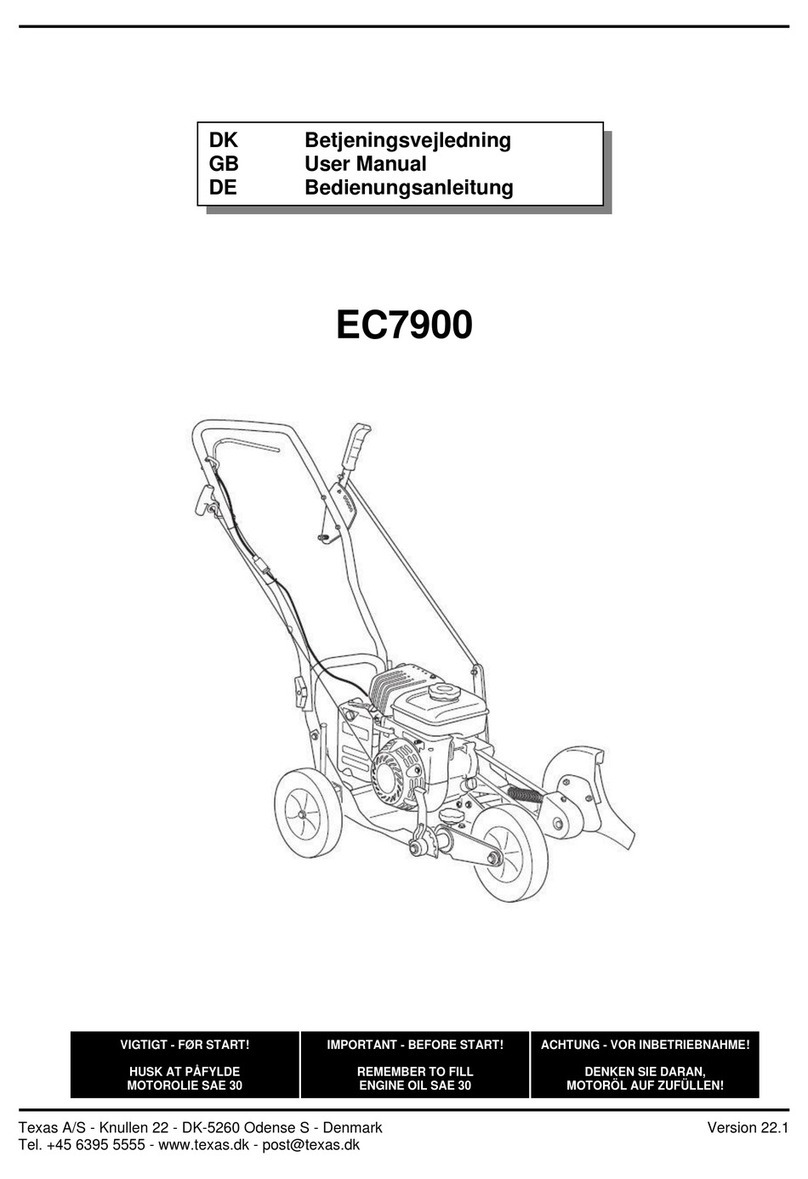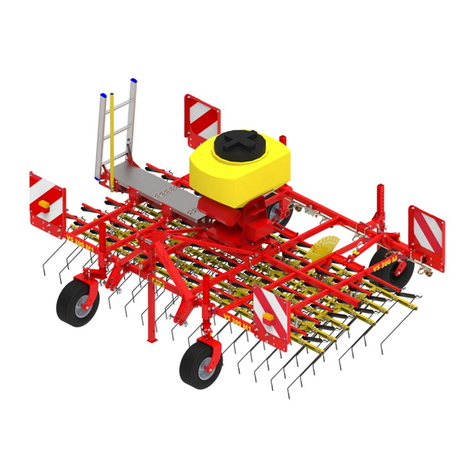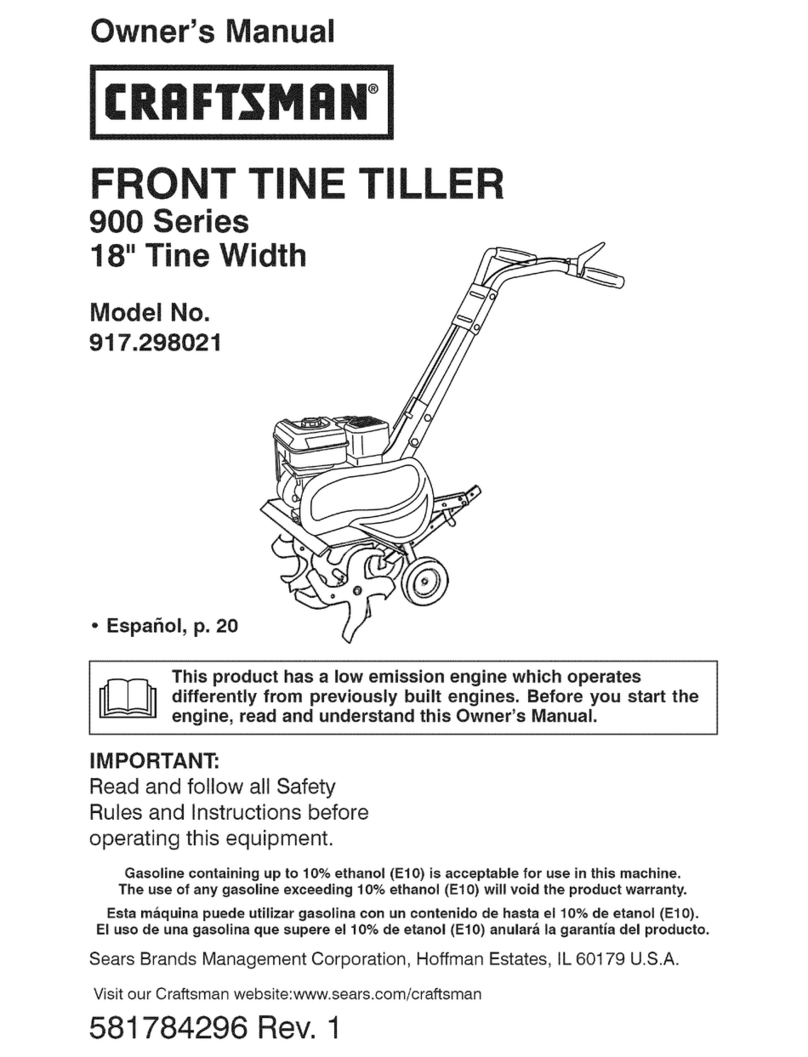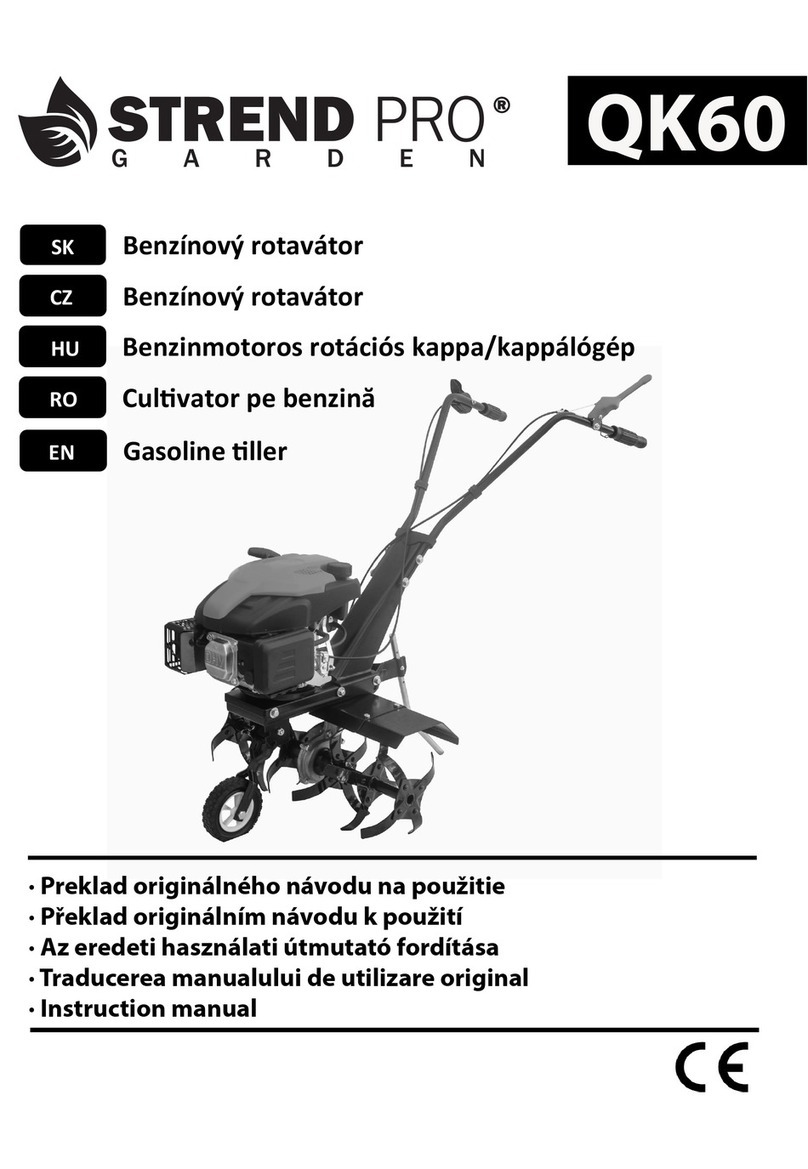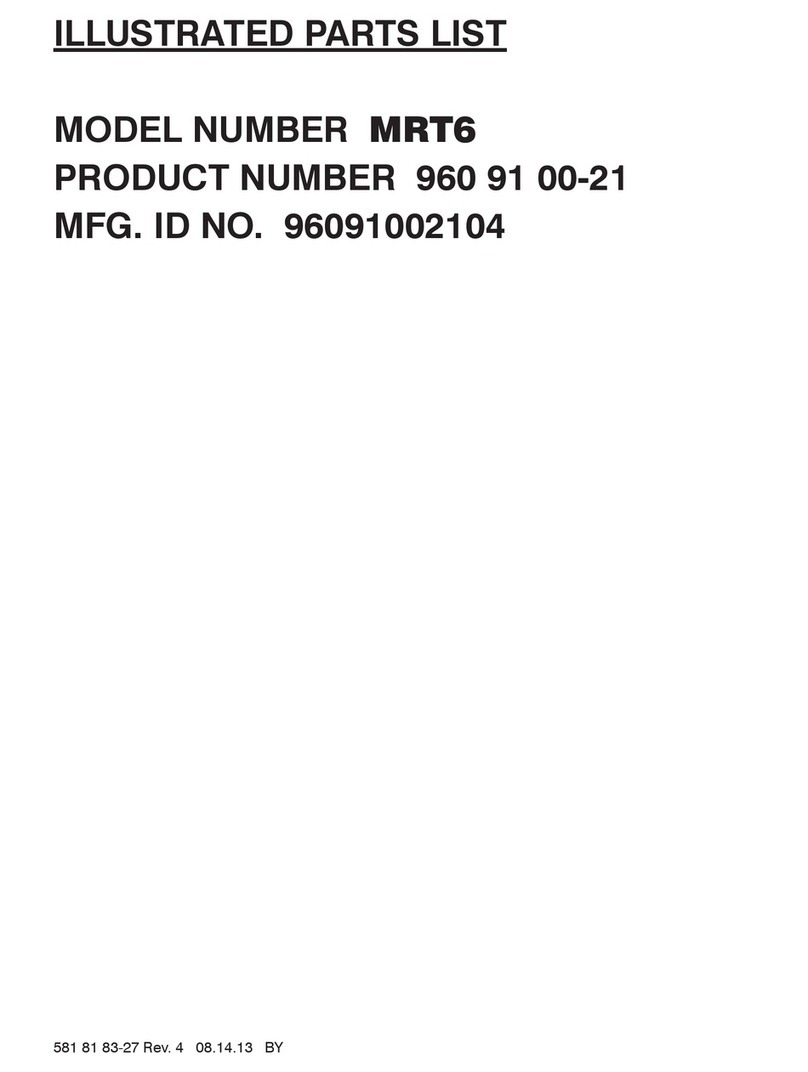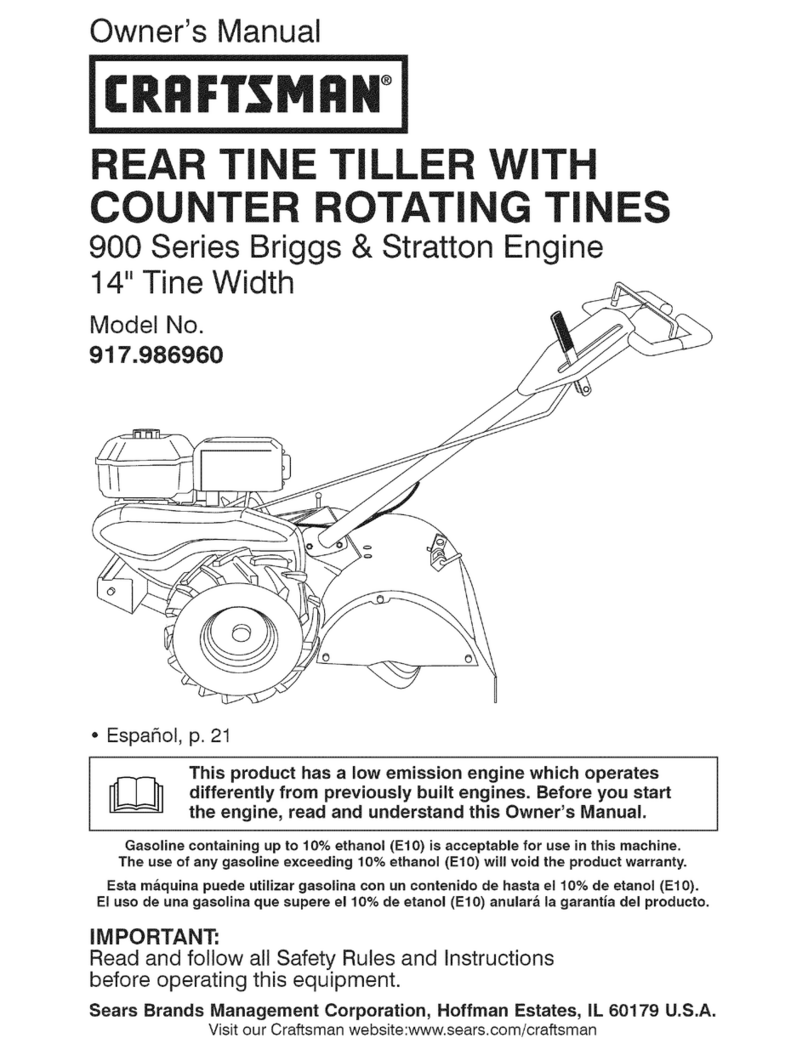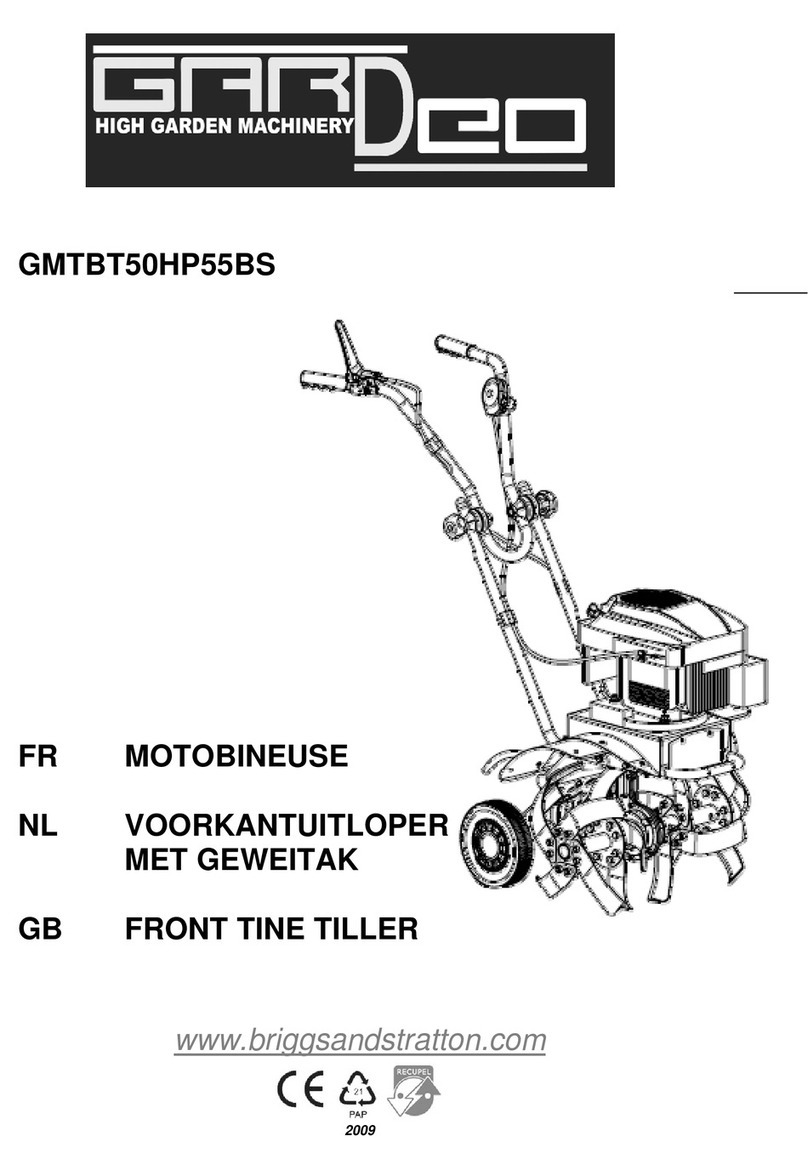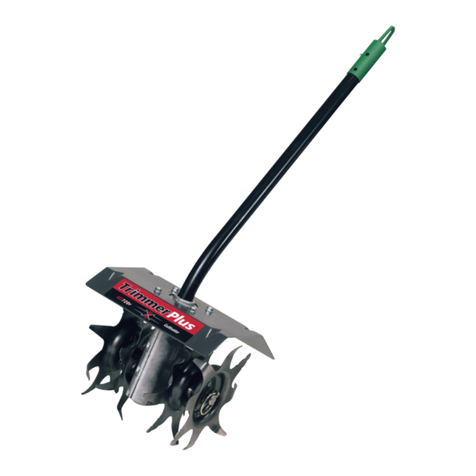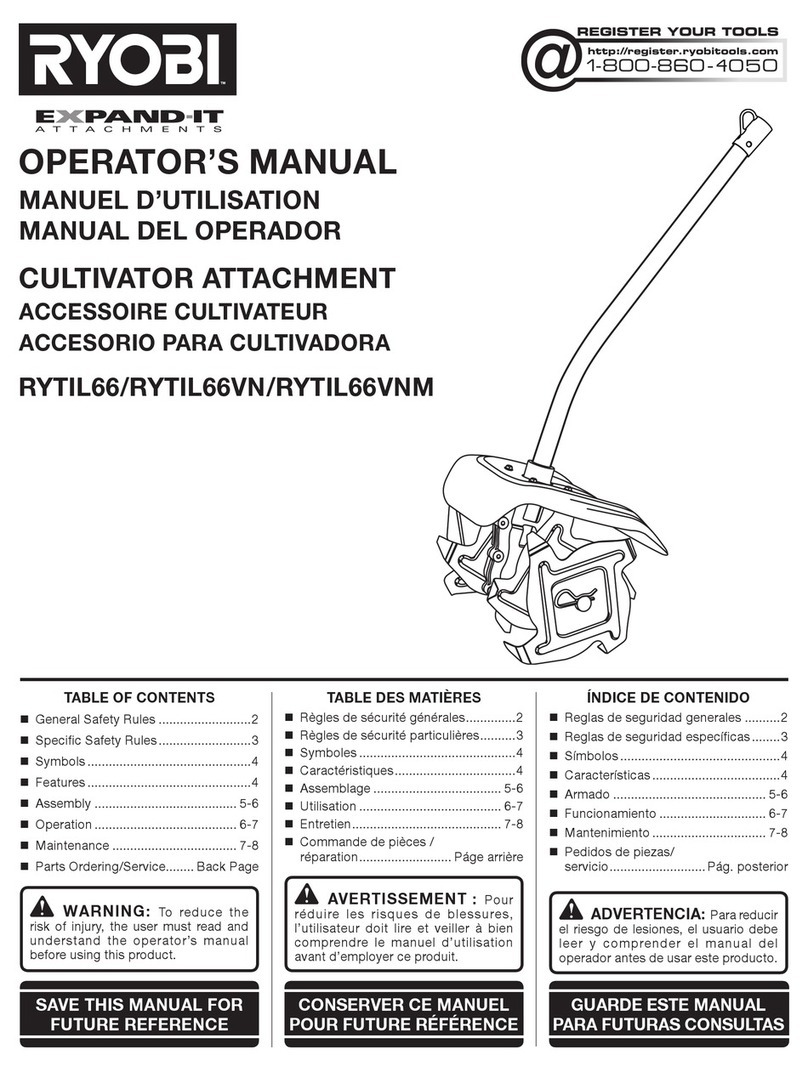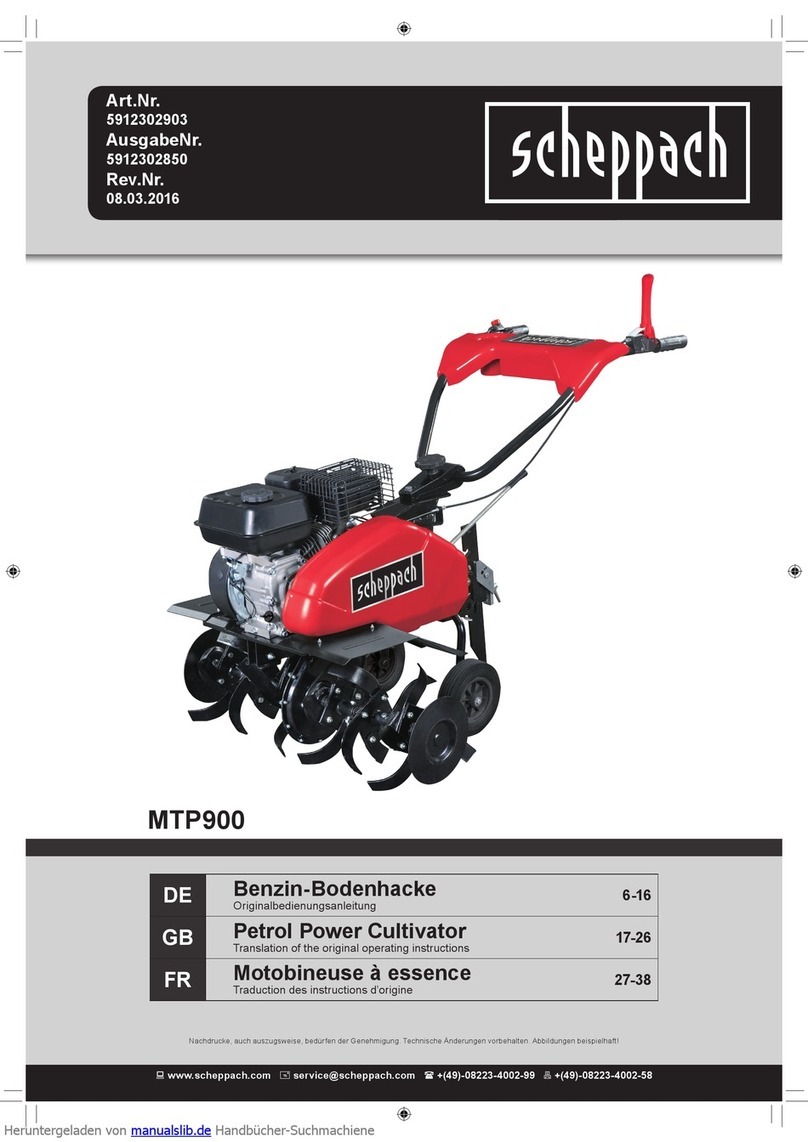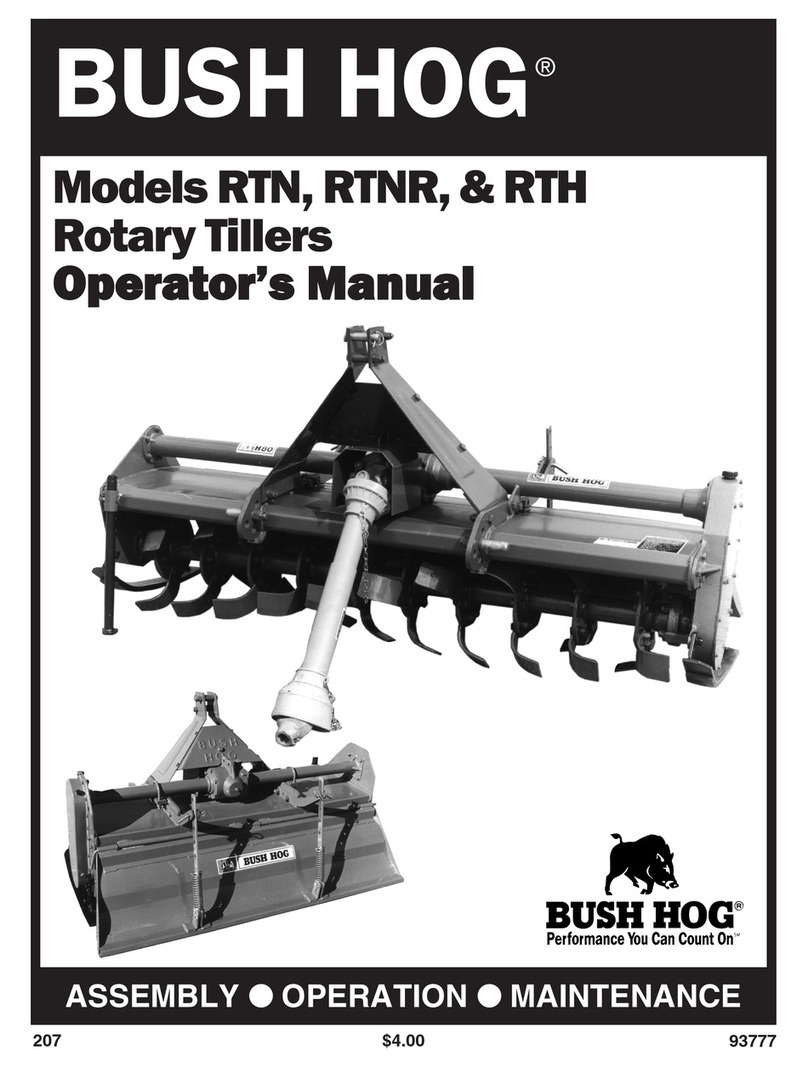SKY Agriculture Methys HDS User manual

Réf: 401 287-01 FR-EN-DE
Methys HDS (type homologué OS01.../PS01...)
Déchaumeur trainé
Notice originale
Original Instructions
Originalbetriebsanleitung
10/05/2021
A LIRE ATTENTIVEMENT AVANT D’UTILISER LA MACHINE
PLEASE READ CAREFULLY BEFORE USING THE MACHINE
VOR INBETRIEBNAHME SORGFÄLTIG LESEN!
BUREL SOLUTION
P.A. de la Gaultière
35220 CHATEAUBOURG - France
Tél :(33)02 99 00 84 84
Web : www.sulky-burel.com


Cher utilisateur / Dear Customer / Geehrter Kunde
EN DE
Dear Customer,
Thank you for trusting our equipment and
choosing the Methys HDS.
To ensure correct operation, and to get the
most out of your Methys HDS, we recommend
that you read these instructions carefully.
Please do not hesitate to give us your sugges-
tions and comments based on your expe-
rience. They are always useful for improving
our products.
We hope your Methys HDS will provide long
and trouble-free service.
Yours sincerely.
J.BUREL
Chairman
Geehrter Kunde,
Sie haben sich für unseren Methys HDS
entschieden.
Wir danken Ihnen für das Vertrauen, das
Sie unseren Geräten entgegenbringen.
Bitte lesen Sie die Anleitung sorgfältig durch,
damit Sie ihren Methys HDS richtig benutzen
und alle seine Möglichkeiten voll nutzen
können.
Zögern Sie nicht, uns Ihre eigenen Beobach-
tungen und Erfahrungen mitzuteilen, die für
die Verbesserung unserer Produkte immer
nützlich sein können.
Wir wünschen Ihnen viel Erfolg mit Ihrem
Methys HDS und verbleiben
mit freundlichen Grüßen
J.BUREL
Präsident
Cher Client,
Vous avez choisi le Methys HDS, et nous vous remercions de votre
conance pour notre matériel.
Pour une bonne utilisation, et pour tirer prot de toutes les capacités
de votre Methys HDS, nous vous recommandons de lire attentivement
cette notice.
De par votre expérience, n’hésitez pas à nous faire part de vos
observations et suggestions, toujours utiles pour l’amélioration de nos
produits.
En vous souhaitant bon usage de votre Methys HDS,
Veuillez agréer, Cher Client, l’assurance de nos meilleurs sentiments.
J. BUREL
Chairman

D ÉCHAUMEUR TRAINÉ
T OWED STUBBLE CULTIVATOR
G EZOGENE SCHEIBENEGGE
F AIT ÀCHÂTEAUBOURG : 4/1/2021
C HÂTEAUBOURG: 4/1/2021
A USGESTELLT IN CHÂTEAUBOURG 4/1/2021
D IE MASCHINE ENTSPRICHT ALLEN
EINSCHLÄGIGEN BESTIMMUNGEN DER
MASCHINENRICHTLINIE 2006/42/EG
Julien BUREL
PA DE LA GAULTIÈRE
35220 CHATEAUBOURG FRANCE
Selon annexe 2, partie 1, point A de la directive « machines » 2006/42/CE.
In accordance with Appendix 2, Section 1, Point A of the European Machinery Directive 2006/42/EC.
Gemäß Anhang II, Teil 1, Abschnitt A der Maschinenrichtlinie 2006/42/EG.
SIGNÉ
SIGNED:
UNTERZEICHNET:
J. BUREL
P RÉSIDENT
C HAIRMAN
P RÄSIDENT
EN DE
N OM DU FABRICANT ET ADRESSE
M ANUFACTURER’SNAME AND ADDRESS:
N AME UND ADRESSE DES HERSTELLERS:
N OM DE LA PERSONNE AUTORISÉE ACONSTITUER LE DOSSIER
TECHNIQUE ET ADRESSE :
N AME AND ADDRESS OF THE PERSON AUTHORISED TO COMPILE THE
TECHNICAL SPECIFICATIONS:
N AME UND ADRESSE DES FÜR DIE ZUSAMMENSTELLUNG DER
TECHNISCHEN UNTERLAGEN BEVOLLMÄCHTIGTEN:
D ESCRIPTION DE LA MACHINE
M ACHINE DESCRIPTION :
B ESCHREIBUNG DER MASCHINE:
T YPE
T YPE :
T YP:
N UMÉRO DE SÉRIE
A CCESSOIRES
A CCESSORIES:
Z USATZAUSRÜSTUNGEN:
S ERIAL NUMBER:
S ERIENNUMMER:
Déclaration de conformité
Declaration of Conformity
Konformitätserklärung
FR
T HE MACHINE CONFORMS TO THE RELEVANT
TERMS OF THE EUROPEAN MAC HINERY
DIRECTIVE 2006/42/EC
THE MACHINE CONFORMS TO THE RELEVANT
TERMS OF «THE SUPPLY OF MACHINERY
(SAFETY) REGULATION 2008»
L AMACHINE EST CONFORME AUX DISPOSITIONS
PERTINENTES DE LA DIRECTIVE MACHINES 2006-
42 CE
Methys HDS (type homologué OS01.../PS01...)
Methys HDS (approved type: OS01.../PS01...)
Methys HDS (Bauartzulassung: OS01.../PS01...)
BUREL PRODUCTION
PA DE LA GAULTIERE
35220 CHATEAUBOURG - FRANCE

PRESCRIPTIONS GÉNÉRALES DE SÉCURITÉ
Avant chaque utilisation et mise en service de
l’ensemble tracteur-machine, s’assurer de sa
conformité avec la réglementation en matière de
sécurité du travail et avec les dispositions du Code
de la Route.
GÉNÉRALITÉS
1 - Respecter, en plus des instructions contenues dans
cette notice, la législation relative aux prescriptions
de sécurité et de prévention des accidents.
2 - Les avertissements apposés sur la machine
fournissent des indications sur les mesures de
sécurité à observer et contribuent à éviter les
accidents.
3 - Lors de la circulation sur la voie publique, respecter
les prescriptions du Code de la Route.
4 - Avant de commencer le travail, l’utilisateur devra
se familiariser obligatoirement avec les organes de
commande et de manœuvre de la machine et leurs
fonctions respectives. En cours de travail, il sera trop
tard pour le faire.
5 - L’utilisateur doit éviter de porter des vêtements
ottants qui risqueraient d’être happés par des
éléments en mouvement.
6 - Il est recommandé d’utiliser un tracteur équipé
d’une cabine ou d’un arceau de sécurité, aux normes
en vigueur.
7 - Avant la mise en route de la machine et le
démarrage des travaux, contrôler les abords
immédiats (enfant !). Veiller à avoir une visibilité
susante ! Eloigner toute personne ou animal de la
zone de danger de la machine (projections !).
8 - Le transport de personnes ou d’animaux sur la
machine lors du travail ou lors des déplacements est
strictement interdit.
9 - L’accouplementdelamachineautracteurnedoitse
faire que sur les points d’attelage prévus à cet eet
conformément aux normes de sécurité en vigueur.
10 - La prudence est de rigueur lors de l’attelage de la
machine au tracteur et lors de son désaccouplement!
11 - Avant d’atteler la machine, il conviendra de
s’assurer que le lestage de l’essieu avant du tracteur
est susant. La mise en place des masses de lestage
doit se faire sur les supports prévus à cet eet
conformément aux prescriptions du constructeur du
tracteur.
12 - Respecter la charge à l’essieu maximum et le
poids total roulant autorisé en charge.
13 - Respecter le gabarit maximum sur la voie
publique.
14 - Avant de s’engager sur la voie publique, veiller
à la mise en place et au bon fonctionnement des
protecteurs et dispositifs de signalisation (lumineux,
rééchissants…) exigés par la loi. Remplacer
les ampoules grillées par des types et couleurs
identiques.
15 - Toutes les commandes à distance (corde,
câble, tringle, exible…) doivent être positionnées
de telle sorte qu’elles ne puissent déclencher
accidentellement une manœuvre génératrice de
risque d’accident ou de dégâts.
16 - Avant de s’engager sur la voie publique, placer
la machine en position de transport, conformément
aux indications du constructeur.
17 - Ne jamais quitter le poste de conduite lorsque le
tracteur est en marche.
18 - Lavitesse et lemode de conduitedoiventtoujours
être adaptés aux terrains, routes et chemins. En toute
circonstance, éviter les brusques changements de
direction.
19 - La précision de la direction, l’adhérence du
tracteur, la tenue de route et l’ecacité des dispositifs
de freinage sont inuencées par des facteurs tels
que : poids et nature de la machine attelée, lestage
de l’essieu avant, état du terrain ou de la chaussée. Il
est donc impératif de veiller au respect des règles de
prudence dictées par chaque situation.
20 - Redoubler de prudence dans les virages en
tenant compte du porte-à-faux, de la longueur, de la
hauteur et du poids de la machine ou de la remorque
attelée.
21 - Avant toute utilisation de la machine, s’assurer
que tous les dispositifs de protection sont en place
et en bon état. Les protecteurs endommagés doivent
être immédiatement remplacés.
22 - Avant chaque utilisation de la machine,
contrôler le serrage des vis et des écrous, en
particulier de ceux qui xent les outils (disques,
palettes, déecteurs…). Resserrer si nécessaire.
23 - Nepasstationnerdanslazonedemanœuvredela
machine.
24 - Attention ! Des zones d’écrasement et de
cisaillement peuvent exister sur les organes
commandés à distance, notamment ceux asservis
hydrauliquement.
25 - Avant de descendre du tracteur, ou
préalablement à toute intervention sur la machine,
couper le moteur, retirer la clé de contact et attendre
l’arrêt complet de toutes les pièces en mouvement.
26 - Ne pas stationner entre le tracteur et la machine
sans avoir préalablement serré le frein de parcage et/
ou avoir placé des cales sous les roues.
27 - Avant toute intervention sur la machine,
s’assurer que celle-ci ne puisse être mise en route
accidentellement.
28 - Ne pas utiliser l’anneau de levage pour lever la
machine lorsqu’elle est remplie.
29 - La hauteur de votre machine, ainsi que
sa composition métallique vous impose des
précautions an d’éviter tous risques électriques :
1- Vérier que la hauteur de votre machine soit
inférieure à la hauteur des lignes électriques sous
lesquelles la machine doit évoluer
a. Jusqu’à 1kV : 1 m
b. De 1 à 110 kV : 2 m
c. De 110 à 220 kV : 3 m
d. De 220 à 380 kV : 4 m
e. Plus de 380 kV : Consulter les consignes
spéciques
2- An d’éviter tout risque avec la foudre, s’informer
sur les conditions météorologiques et éviter de
travailler lorsque les conditions sont dangereuses,
éviter les points hauts, s’éloigner et ne pas toucher
les structures métalliques (pylônes, grilles, poteaux,
clôtures, etc.).
30 - Les pneumatiques de votre matériel étant
sous pression, ils constituent un réel risque pour
l’utilisateur. Leur manutention, réparation ou
leur montage ne doit être eectué que par des
techniciens formés à ces opérations. Pour le
gonage, se référer au chapitre et à la section
appropriée.
31 - Pour toute intervention sur la machine
(chargement, réglage, lavage, …) il est impératif de
poser la machine au sol.
32 - Si votre machine est équipée d’un essieu routier
freiné, alors toujours s’assurer que la source de
freinage disponible sur le tracteur soit bien adaptée
au type de freinage nécessaire sur votre machine
(hydraulique / pneumatique).
UTILISATION CONFORME DE LA MACHINE
1 - En toutes situations, la machine ne doit être
utilisée que par une seule personne.
2 - La machine ne doit être utilisée que pour les
travaux pour lesquels elle a été conçue. En cas de
dommage lié à l’utilisation de la machine hors du
cadre des applications spéciées par le constructeur,
la responsabilité de celui-ci sera entièrement
dégagée.
3 - Touteextrapolationdeladestinationd’originedela
machine se fera aux risques et périls de l’utilisateur.
4 - L’utilisation conforme de la machine implique
également :
- le respect des prescriptions d’utilisation, d’entretien
et de maintenance édictées par le constructeur,
- l’utilisation exclusive de pièces de rechange,
d’équipements et d’accessoires d’origine ou
préconisés par le constructeur.
5 - La machine ne doit être utilisée, entretenue et
réparée que par des personnes compétentes,
familiarisées avec les caractéristiques et modes
d’utilisation de la machine. Ces personnes doivent
aussi être informées des dangers auxquels elles
pourraient être exposées.
6 - L’utilisateur est tenu au respect scrupuleux de la
réglementation en vigueur en matière de :
- prévention contre les accidents,
- sécurité du travail (Code du Travail),
- circulation sur la voie publique (Code de la Route).
- Il lui est fait obligation d’observer strictement les
avertissements apposés sur la machine.
7 - Toute modication de la machine eectuée par
l’utilisateur lui-même ou toute autre personne, sans
l’accord écrit préalable du constructeur, engagera la
responsabilité du propriétaire du matériel modié.
8 - La valeur d’émission de bruit mesurée au poste de
conduite cabine fermée.
(Niveau de pression acoustique) est de 75 dB(A)
Appareil de mesure : SL 401
Position du microphone positionné selon le
paragraphe B.2.6 de l’annexe B de la NF EN ISO
4254-1.
Ce niveau de pression acoustique dépend, pour
l’essentiel, du tracteur utilisé.
Prescriptions de sécurité
ГCes symboles sont utilisés dans cette notice chaque fois que des recommandations concernent votre sécurité, celle d’autrui ou
le bon fonctionnement de la machine.
ГTransmettez impérativement ces recommandations à tout utilisateur de la machine.
FR
Faciliter le travailRisque d’accident
Risque
d’endommager la
machine

ATTELAGE
1 - Pendant les phases d’attelage et de dételage
et si votre machine est équipée de béquille, veiller
à ce que l’axe de verrouillage de la béquille soit
correctement verrouillé.
2 - Lors de l’attelage de la machine au tracteur ou de
sa dépose, placer le levier de commande du relevage
hydraulique dans une position telle que toute entrée
en action du relevage ne puisse intervenir de façon
inopinée.
3 - Lors de l’attelage de la machine au relevage 3
points du tracteur, veiller à ce que les diamètres
des broches ou tourillons correspondent bien aux
diamètres des rotules du tracteur.
4 - Attention ! Dans la zone de relevage 3 points, il
existe des risques d’écrasement et de cisaillement!
5 - Ne pas se tenir entre le tracteur et la machine lors
de la manœuvre du levier de commande extérieur
du relevage.
6 - Au transport la machine doit être stabilisée par
les tirants de rigidication du relevage pour éviter
tout ottement et débattement latéral.
7 - Lors du transport de la machine en position
relevée, verrouiller le levier de commande du
relevage.
8 - Ne jamais dételer la machine lorsque la trémie
est remplie.
ORGANES D’ANIMATION
(Prises de force et arbres de transmission à cardans)
1 - N’utiliser que les arbres de transmission à
cardans fournis avec la machine ou préconisés par
le constructeur.
2 - Les protecteurs des prises de force et des arbres
de transmission à cardans doivent toujours être en
place et en bon état.
3 - Veiller au recouvrement correct des tubes des
arbres de transmission à cardans, aussi bien en
position de travail qu’en position de transport.
4 - Avant de connecter ou de déconnecter un arbre
de transmission à cardans, débrayer la prise de force,
couper le moteur et retirer la clé de contact.
5 - Si l’arbre de transmission à cardans primaire est
équipé d’un limiteur de couple ou d’une roue libre,
ceux-ci doivent impérativement être montés sur la
prise de force de la machine.
6 - Veiller toujours au montage et au verrouillage
corrects des arbres de transmission à cardans.
7 - Veiller toujours à ce que les protecteurs des arbres
de transmission à cardans soient immobilisés en
rotation à l’aide des chaînettes prévues à cet eet.
8 - Avant d’embrayer la prise de force, s’assurer que
le régime choisi et le sens de rotation de la prise
de force sont conformes aux prescriptions du
constructeur.
9 - Avant d’embrayer la prise de force, s’assurer
qu’aucune personne ou animal ne se trouve à
proximité de la machine.
10 - Débrayer la prise de force lorsque les limites
de l’angle de l’arbre de transmission à cardans
prescrites par le constructeur risquent d’être
dépassées.
11 - Attention!Aprèsle débrayagede laprisedeforce,
les éléments en mouvement peuvent continuer
à tourner quelques instants encore. Ne pas s’en
approcher avant immobilisation totale.
12 - Lors de la dépose de la machine, faire reposer les
arbres de transmission à cardans sur les supports
prévus à cet eet.
13 - Après avoir déconnecté l’arbre de transmission
à cardans de la prise de force du tracteur, celle-ci
doit être recouverte de son capuchon protecteur.
14 - Les protecteurs de prise de force et d’arbres de
transmission à cardans endommagés doivent être
remplacés immédiatement.
CIRCUIT HYDRAULIQUE
1 - Attention ! Le circuit hydraulique est sous pression.
2 - Lors du montage de vérins ou de moteurs
hydrauliques, veiller attentivement au branchement
correct des circuits, conformément aux directives du
constructeur.
3 - Avantdebrancherunexibleaucircuithydraulique
du tracteur, s’assurer que les circuits côté tracteur et
côté machine ne sont pas sous pression.
4 - Il est vivement recommandé à l’utilisateur de la
machine de suivre les repères d’identication sur les
raccords hydrauliques entre le tracteur et la machine
an d’éviter des erreurs de branchement. Attention !
Il y a risque d’interversion des fonctions (parexemple :
relever/abaisser).
5 - Contrôlerunefoisparanlesexibleshydrauliques:
. Blessure de la couche extérieure
. Porosité de la couche extérieure
. Déformation sans pression et sous pression
. Etat des raccords et des joints
La durée d’utilisation maximum des exibles est de
6 ans. Lors de leur remplacement, veiller à n’utiliser
que des exibles de caractéristiques et de qualité
prescrits par le constructeur de la machine.
6 - Lors de la localisation d’une fuite, il conviendra
de prendre toute précaution visant à éviter les
accidents.
7 - Tout liquide sous pression, notamment l’huile
du circuit hydraulique, peut perforer la peau et
occasionner de graves blessures ! En cas de blessure,
consulter de suite un médecin ! Il y a danger
d’infection !
8 - Avant toute intervention sur le circuit
hydraulique, abaisser la machine, mettre le circuit
hors pression, couper le moteur et retirer la clé de
contact.
ENTRETIEN
1 - Avant tous travaux de maintenance, d’entretien
ou de réparation, ainsi que lors de la recherche
de l’origine d’une panne ou d’un incident de
fonctionnement, il faut impérativement que la prise
de force soit débrayée, que le moteur soit coupé et la
clé de contact retirée.
2 - Contrôler régulièrement le serrage des vis et des
écrous. Resserrer si nécessaire !
3 - Avantdeprocéderàdestravauxd’entretiensurune
machine en position relevée, étayer celle-ci à l’aide
d’un moyen approprié.
4 - Lors du remplacement d’une pièce travaillante,
(pale pour les distributeurs ou socs pour les semoirs),
mettre des gants de protection et n’utiliser qu’un
outillage approprié.
5 - Pourlaprotectiondel’environnement,ilestinterdit
de jeter ou de déverser les huiles, graisses et ltres en
tout genre. Les coner à des entreprises spécialisées
dans leur récupération.
6 - Avant toute intervention sur le circuit électrique,
déconnecter la source d’énergie.
7 - Les dispositifs de protection susceptibles d’être
exposés à une usure doivent être contrôlés
régulièrement. Les remplacer immédiatement s’ils
sont endommagés.
8 - Les pièces de rechange doivent répondre
aux normes et caractéristiques dénies par le
constructeur. N’utiliser que des pièces de rechange
Sulky !
9 - Avant d’entreprendre des travaux de soudure
électrique sur le tracteur ou la machine attelée,
débrancher les câbles de l’alternateur et de la
batterie.
10 - Les réparations aectant les organes sous
tension ou pression (ressorts, accumulateurs de
pression...) impliquent une qualication susante et
font appel à un outillage spécique ; aussi ne doivent-
elles être eectuées que par un personnel qualié.
11 - Tous les composants ainsi que les dispositifs de
protection, présentant un état de corrosion avancé,
doivent être immédiatement remplacés.
12 - Lors des travaux d’entretien ou de réparation,
l’opérateur devra travailler en toute sécurité et si
nécessaire utiliser des solutions adaptées et en
phase avec la législation du travail, notamment
pour le travail en hauteur.
PROTECTION DE L’UTILISATEUR
1 - Ne marchez pas sur les capots ni sur aucun autre
endroit de la machine, à l’exception des zones
(échelles, plate-forme, moyens d’accès au poste de
travail ou de réglage)
2 - Avant toute intervention sur la machine,
s’assurer que celle-ci ne peut être mise en route
accidentellement.
3 - Il est conseillé d’avoir à proximité de la main une
trousse de premier secours.
4 - Eviter tout contact avec la peau, les yeux, et la
bouche de produits tels que des lubriants, solvants,
antigels, produits de nettoyages et produits
phytopharmaceutiques.
5 - En cas d’incident, consulter immédiatement un
médecin.
6 - Respecterscrupuleusementlesindicationsportées
sur les étiquettes de sécurité des récipients des
produits utilisés.
7 - Le uide hydraulique sous pression qui s’échappe
peut avoir une force susante pour pénétrer la
peau et provoquer de graves blessures. Dans ce cas
consulter immédiatement un médecin.
8 - Lors du chargement, du réglage, de l’utilisation, de
l’entretien et du lavage de la machine, l’utilisateur
doit porter les éléments de protection individuels
adaptés aux produits utilisés avec la machine .
L’utilisateur doit être protégé par le port d’une
combinaison, des gants, des lunettes, des chaussures
de sécurité et un masque. Ces éléments de
protection doivent assurer un niveau de protection
adapté aux produits utilisés avec la machine, il faut
se référer aux prescriptions de sécurité des produits
utilisés.
PROTECTION DE L’ENVIRONNEMENT
1 - Veiller à ne pas répandre sur le sol et à ne pas jeter
dans les égouts les graisses usagées et les substances
telles que les huiles, les graisses, ou les reliquats de
produits après usage.
2 - Il est interdit de stocker, d’abandonner, de
déposer dans un milieu naturel ou de brûler les
pneumatiques. Rapportez-les à un distributeur ou à
un collecteur agréé.
3 - Intervenir lorsque les conditions météorologiques
sont favorables à l’ecacité maximale du produit
phytosanitaire utilisé en limitant au maximum
l’impact de ce dit produit sur l’environnement.
FR

GENERAL SAFETY REGULATIONS
Every time the tractor/machine assembly is to be
started up and used, you should ensure beforehand
that it complies with current legislation on safety at
work and Road Trac regulations.
GENERAL
1 - In addition to the instructions contained in this
manual, legislation relating to safety instructions
and accident prevention should be complied with.
2 - Warnings axed to the machine give indications
regarding safety measures to be observed and help
to avoid accidents.
3 - When travelling on public roads, abide by the
provisions of the Highway Code.
4 - Before starting work, it is essential that the user
familiarizes himself with the control and operating
elements of the machine and their respective
functions. When the machine is running, it may be
too late.
5 - The user should avoid wearing loose clothing
which may be caught up in the moving parts.
6 - We recommend using a tractor with a safety cab
or roll bar conforming to standards in force.
7 - Before starting up the machine and beginning
work, check the immediate surroundings,
particularly for children. Make sure that visibility is
adequate. Clear any persons or animals out of the
danger zone.
8 - It is strictly forbidden to transport any persons
or animals on board the machine whether it is in
operation or not.
9 - The machine should only be coupled up to the
tractor at the specially provided towing points and in
accordance with applicable safety standards.
10 - Extreme care must be taken when coupling or
uncoupling the machine from the tractor.
11 - Before hitching up the machine, ensure that
the front axle of the tractor is suciently weighted.
Ballast weights should be tted to the special
supports in accordance with the instructions of the
tractor manufacturer.
12 - Do not exceed the maximum axle weight or the
gross vehicle weight rating.
13 - Do not exceed the maximum authorized
dimensions for using public roads.
14 - Before entering a public road, ensure that the
protective and signalling devices (lights, reectors,
etc.) required by law are tted and working properly.
Replace burnt out bulbs with the same types and
colours.
15 - All remote controls (cords, cables, rods, hoses,
etc.) must be positioned so that they cannot
accidentally set o any manoeuvre which may cause
an accident or damage.
16 - Before entering a public road, place the machine
in the transport position, in accordance with the
manufacturer’s instructions.
17 - Never leave the driver’s position whilst the
tractor is running.
18 - The speed and the method of operation must
always be adapted to the land, roads and paths.
Avoid sudden changes of direction under all
circumstances.
19 - Precision of the steering, tractor adhesion, road
holding and eectiveness of the braking mechanism
are inuenced by factors such as the weight and nature
of the machine being towed, the front axle stage and the
state of the land or path. It is essential, therefore, that
the appropriate care is taken for each situation.
20 - Take extra care when cornering, taking account
of the overhang, length, height and weight of the
machine or trailer being towed.
21 - Before using the machine, ensure that
all protective devices are tted and in good
condition. Damaged protectors should be replaced
immediately.
22 - Before using the machine, check that nuts and
screws are tight, particularly those for attaching
tools (discs, ickers, deectors, etc.). Tighten if
necessary.
23 - Do not stand in the operating area of the
machine.
24 - Caution! Be aware of any crushing and shearing
zones on remote-controlled and particularly
hydraulically-controlled parts.
25 - Before climbing down from the tractor, or before
any operation on the machine, turn o the engine,
remove the key from the ignition and wait until all
moving parts have come to a standstill.
26 - Do not stand between the tractor and the
machine until the handbrake has been applied and/
or the wheels have been wedged.
27 - Before any operation on the machine, ensure
that it cannot be started up accidentally.
28 - Do not use the lifting ring to lift the machine
when it is loaded.
29 - The height of your machine and its metal
construction mean that you must take precautions
to avoid any electrical risks:
1- Check that the height of your machine is lower
than the height of the electrical lines under which
the machine must pass
a. Up to 1kV : 1 m
b. From 1 to 110 kV : 2 m
c. From110 to 220 kV : 3 m
d. From 220 to 380 kV : 4 m
e. Over 380 kV : See the specic
instructions
2- To avoid any lightning risks, check the weather
forecast and avoid working when the conditions
are dangerous, avoid high points and move away
from and do not touch metal structures (pylons,
grilles, posts, fences, etc.).
30 - As your equipment’s tyres are pressurised, they
constitute a real risk to the user. They must only be
handled, repaired or tted by technicians who are
trained in these operations. For ination, refer to the
appropriate chapter and section.
31 - The machine must be placed on the ground
when carrying out an interventions on it (loading,
adjustment, lifting, etc.).
32 - If your machine is equipped with a braked road
axle, then always make sure that the braking source
available on the tractor is fully adapted to the type
of braking necessary on your machine (hydraulic/
pneumatic).
PROPER USE OF THE MACHINE
1 - In all situations, the machine must only be used
by one person.
2 - The machine must only be used for tasks for
which it has been designed. The manufacturer will
not be liable for any damage caused by using the
machine for applications other than those specied
by the manufacturer.
3 - Using the machine for purposes other than those
originally intended will be done so entirely at the
user’s risk.
4 - Proper use of the machine also implies:
- complying with instructions on use, care and
maintenance provided by the manufacturer;
- using only original or manufacturer recommended
spare parts, equipment and accessories.
5 - The machine must only be operated, maintained
and repaired by competent persons, familiar with
the specications and methods of operation of the
machine. These persons must also be informed of
the dangers to which they may be exposed.
6 - The user must strictly abide by current legislation
regarding:
- accident prevention;
- safety at work (Health and Safety Regulations);
- transport on public roads (Road Trac
Regulations).
Strict compliance with warnings axed to the
machine is obligatory.
7 - The owner of the equipment shall become liable
for any damage resulting from alterations made to
the machine by the user or any other person, without
the prior written consent of the manufacturer.
8 - The noise emission value measured at the driving
position with the cab closed (level of acoustic
pressure) is 75 dB(A).
Measuring device: SL 401
Position of the microphone placed in accordance
with Paragraph B 2.6 of Appendix B of NF EN ISO
4254-1.
This level of acoustic pressure essentially depends on
the tractor used.
HITCHING
1 - During hitching and unhitching phases and if
your machine is equipped with a stand, ensure that
the stand locking pin is properly locked.
2 - When hitching or unhitching the machine from
the tractor, place the control lever of the hydraulic lift
in such a position that the lifting mechanism cannot
be activated accidentally.
3 - When hitching the machine to the three-point
lifting mechanism of the tractor, ensure that the
diameters of the pins or gudgeons correspond to the
diameter of the tractor ball joints.
4 - Caution! In the three-point lifting zone, there may
be a danger of crushing and shearing.
5 - Do not stand between the tractor and the
machine whilst operating the external lift control
lever.
6 - When in transport, lifting mechanism stabilizer
bars must be tted to the machine to avoid oating
and side movement.
7 - When transporting the machine in the raised
position, lock the lift control lever.
Safety regulations
ГThese symbols are used in these instructions every time recommendations are provided concerning your safety, the safety of
others or the correct operation of the machine.
ГThese recommendations must be given to all users of the machine.
EN
Operating tipRisk of accident
Risk of damage
to the machine

8 - Never unhitch the machine when the hopper is
lled.
DRIVE EQUIPMENT
(Power take-o and universal drive shafts)
1 - Only use universal drive shafts supplied with the
machine or recommended by the manufacturer.
2 - Power take-o and universal drive shaft guards
must always be tted and in good condition.
3 - Ensure that the tubes of the universal drive shafts
are properly guarded, both in the working position
and in the transport position.
4 - Before connecting or disconnecting a universal
drive shaft, disengage the power take-o, turn o
the engine and re-move the key from the ignition.
5 - If the primary universal drive shaft is tted with
a torque limiter or a free wheel, these must be
mounted on the machine power take-o.
6 - Always ensure that universal drive shafts are
tted and locked correctly.
7 - Always ensure that universal drive shaft guards
are immobilized in rotation using the specially
provided chains.
8 - Before engaging power take-o, ensure that
the speed selected and the direction of rotation of
the power take-o comply with the manufacturer’s
instructions.
9 - Before engaging power take-o, ensure that no
persons or animals are close to the machine.
10 - Disengage power take-o when the
universal drive shaft angle limits laid down by the
manufacturer are in danger of being exceeded.
11 - Caution! When power take-o has been
disengaged, moving parts may continue to rotate
for a few moments. Do not approach until they
have reached a complete standstill.
12 - On removal from the machine, rest the universal
drive shafts on the specially provided supports.
13 - After disconnecting the universal drive shafts
from the power take-o, the protective cap should
be tted to the power take-o.
14 - Damaged power take-o and universal drive
shaft guards must be replaced immediately.
HYDRAULIC CIRCUIT
1 - Caution! The hydraulic circuit is pressurized.
2 - When tting hydraulic motors or cylinders,
ensure that the circuits are connected correctly in
accordance with the manufacturer’s guidelines.
3 - Before tting a hose to the tractor’s hydraulic
circuit, ensure that the tractor-side and machine-
side circuits are not pressurized.
4 - The user of the machine is strongly
recommended to identify the hydraulic couplings
between the tractor and the machine in order to
avoid wrong connection. Caution! There is a danger
of reversing the functions (for example: raise/lower).
5 - Check hydraulic hoses once a year:
. Damage to the outer surface
. Porosity of the outer surface
. Deformation with and without pressure
. State of the ttings and seals
The maximum working life for hoses is 6 years.
When replacing them, ensure that only hoses with
the specications and grade recommended by the
machine manufacturer are used.
6 - When a leak is found, all necessary precautions
should be taken to avoid accidents.
7 - Pressurized liquid, particularly hydraulic circuit
oil, may cause serious injury if it comes into contact
with the skin. If the case of injury, consult a doctor
immediately. There is a risk of infection.
8 - Before any operation on the hydraulic circuit,
lower the machine, release the pressure from the
circuit, turn o the engine and remove the key from
the ignition.
MAINTENANCE
1 - Before commencing any maintenance, servicing
or repair work, or before attempting to locate the
source of a breakdown or fault, it is essential that the
power take-o is disengaged, the engine turned o
and the key removed from the ignition.
2 - Check regularly that nuts and screws are not
loose. Tighten if necessary.
3 - Before carrying out maintenance work on a
raised machine, prop it up using appropriate means
of support.
4 - When replacing a working part (fertilizer
spreader blade or seed drill coulter), wear protective
gloves and only use appropriate tools.
5 - To protect the environment, it is forbidden to
throw away oil, grease or lters of any kind. Give
them to specialist recycling rms.
6 - Before operating on the electric circuit,
disconnect the power source.
7 - Protective devices likely to be exposed to wear
and tear should be checked regularly. Replace them
immediately if they are damaged.
8 - Spare parts should comply with the standards
and specications laid down by the manufacturer.
Only use the manufacturer’s spare parts.
9 - Before commencing any electric welding work
on the tractor or the towed machine, disconnect the
alternator and battery cables.
10 - Repairs aecting parts under stress or pressure
(springs, pressure accumulators, etc.) should be
carried out by suitably qualied engineers with
special tools.
11 - All components and protection mechanisms
that show signs of severe corrosion must be replaced
immediately.
12 - During servicing or repair work, the operator is
required to work safely and, where necessary, use
suitable solutions in line with applicable labour
laws, especially as regards work at heights.
USER PROTECTION
1 - Do not walk on the covers or on any other part
of the machine except for zones (ladders, platforms
other resources) to access or adjust the workstation
2 - Before carrying out any work on the machine,
make sure it cannot be started up accidentally.
3 - We recommend keeping a rst aid kit nearby.
4 - Prevent any products such as lubricants,
solvents, anti-freeze, cleaning products and phyto-
pharmaceutical products from coming into contact
with the skin, eyes or mouth.
5 - Contact a doctor immediately if an incident
occurs.
6 - Follow to the letter the indications on the safety
labels of the products used.
7 - Escaping pressurised hydraulic uid may have
enough force to penetrate the skin and cause serious
injury. Contact a doctor immediately if this happens.
8 - Users must wear personal protective equipment
adapted to the products used with the machine
when loading, adjusting, servicing and washing the
machine. Users must protect themselves by wearing
overalls, gloves, glasses, safety shoes and a mask.
These protective elements must provide a suitable
level of protection for the products used with the
machine; refer to the safety instructions of the
products used.
ENVIRONMENTAL PROTECTION
1 - Make sure that you do not spill onto the ground
or discard into the sewers any used grease and
substances such as oil, grease or product remaining
after use.
2 - It is prohibit to store, abandon, dump in the
natural environment or burn tyres. Take them to a
distributor or an approved collector.
3 - Work when the weather conditions favour
maximum eectiveness of the phytosanitary
product used, limiting the impact of this product on
the environment as much as possible.
EN

EALLGEMEINE SICHERHEITSVORSCHRIFTEN
Vor jeder Benutzung und Inbetriebsetzung der
Schlepper-Maschine-Einheit kontrollieren, ob sie
den Sicherheitsvorschriften und den Vorschriften der
Straßenverkehrsordnung entsprechen.
ALLGEMEINES
1 - Zusätzlich zu den in diesem
Handbuch enthaltenen Anweisungen die
Gesetzgebung bezüglich der Sicherheits- und
Unfallverhütungvorschriften einhalten.
2 - Die auf der Maschine angebrachten
Warnungen informieren über die einzuhaltenden
Sicherheitsmaßnahmen und tragen zur
Unfallverhütung bei.
3 - Im Straßenverkehr die Straßenverkehrsordnung
einhalten.
4 - Vor Arbeitsbeginn muß sich der
Benutzer unbedingt mit den Antriebs- und
Bedienungsorganen der Maschine und ihren
jeweiligen Funktionen vertraut machen. Während
der Arbeit ist es dafür zu spät.
5 - Weite Kleidungsstücke, die in sich bewegende
Teile geraten könnten, vermeiden.
6 - Es empehlt sich, gemäß den gültigen
Normen einen Schlepper mit Kabine oder
Sicherheitsverstärkung zu verwenden.
7 - Vor Inbetriebsetzung und Arbeitsbeginn die
direkte Umgebung kontrollieren (Kind!). Für
ausreichende Sicht sorgen! Personen oder Tiere
aus dem Maschinengefahrenbereich entfernen
(Schutzvorrichtungen!).
8 - Der Transport von Personen oder Tieren auf der
Maschine ist während der Arbeit oder beim Fahren
streng verboten.
9 - Die Maschine darf gemäß den geltenden
Sicherheitsnormen nur an den dafür vorgesehenen
Kupplungspunkten angehängt werden.
10 - Besondere Vorsicht ist beim An- und Abbau der
Maschine am Schlepper geboten.
11 - Vor Anhängen der Maschine kontrollieren,
ob der Ballast des Schleppers genügt. Die
Ballastelemente müssen gemäß den Vorschriften
des Schlepperherstellers auf den dafür vorgesehenen
Haltern angebracht werden.
12 - Die maximale Achslast und das zulässige
Gesamtgewicht einhalten.
13 - Das für den Straßenverkehr maximal zulässige
Außenmaß einhalten.
14 - Vor Straßenbenutzung die Schutzvorrichtungen
und Signalisierungsvorrichtungen (Licht- und
Rückstrahlelemente) anbringen und ihre Funktion
prüfen. Die defekten Glühbirnen durch Modelle
identischer Art und Farbe ersetzen.
15 - Alle Fernsteuerungen (Seil, Kabel, Stange,
Schlauch) müssen so positioniert sein, daß sie nicht
ungewollt betätigt werden und dadurch Unfälle oder
Schäden hervorrufen können.
16 - Vor Benutzung der Straße die Maschine gemäß
Herstelleranweisungen in Transportstellung bringen.
17 - Fahrersitz nie bei laufender Maschine verlassen.
18 - Fahrgeschwindigkeit und -weise müssen immer
dem Gelände, den Straßen und Wegen angepaßt
sein. Auf alle Fälle plötzliche Richtungsänderungen
vermeiden.
19 - Die Präzision der Lenkung, die Bodenhaftung
des Schleppers, die Straßenlage und die Wirksamkeit
der Bremsvorrichtungen werden beeinußt von
Faktoren wie: Gewicht und Art der angebauten
Maschine, Belastung der Vorderachse, Zustand des
Geländes oder der Fahrbahn. Die den Bedingungen
entsprechenden Vorsichtsmaßnahmen einhalten.
20 - Besondere Vorsicht ist in Kurven geboten.
Schwerpunktlage, Länge, Höhe und Gewicht der
Maschine oder des Anhängers berücksichtigen.
21 - Vor jeder Benutzung der Maschine kontrollieren,
ob alle Schutzvorrichtungen angebracht und in
gutem Zustand sind. Bei Beschädigung sofort
austauschen.
22 - Vor jeder Benutzung kontrollieren, ob alle
Schrauben und Muttern fest angezogen sind,
insbesondere die, mit denen die Geräte befestigt sind
(Scheiben, Paletten, Schirme...). Notfalls anziehen.
23 - Sich nicht im Manövrierbereich der Maschine
aufhalten.
24 - Vorsicht! Auf den Fernsteuerungsorganen,
insbesondere auf denen mit hydraulischem
Regelkreis, kann es Stauch- und Abscherzonen
geben.
25 - Vor Verlassen des Schleppers oder vor jedem
Eingri auf der Maschine Motor abschalten,
Zündschlüssel abziehen und völligen Stillstand aller
bewegten Teile abwarten.
26 - Sich nicht zwischen Schlepper und Maschine
aufhalten, ohne zuvor die Parkbremse angezogen
und/oder Keile unter die Räder gelegt zu haben.
27 - Vor jedem Eingri an der Maschine
kontrollieren, ob diese nicht ungewollt in Betrieb
gesetzt werden kann.
28 - Die Aufhängöse nicht zum Heben der gefüllten
Maschine benutzen.
29 - Aufgrund der Höhe Ihrer Maschine sowie ihrer
metallischen Zusammensetzung sind bestimmte
Vorsichtsmaßnahmen geboten, um alle elektrischen
Risiken auszuschließen:
1- Stellen Sie sicher, dass die Höhe Ihrer Maschine
niedriger ist als die Höhe der elektrischen
Freileitungen, unter denen die Maschine eingesetzt
werden soll. Dabei gelten folgende Regeln:
a. bis zu 1kV Spannung : 1 m
b. von 1 bis 110 kV Spannung : 2 m
c. von 110 bis 220 kV Spannung : 3 m
d. von 220 bis 380 kV Spannung : 4 m
e. über 380 kV Spannung : Beachten Sie die
spezischen Anweisungen
2- Um jegliches Risiko durch Blitzschlag zu
vermeiden, achten Sie auf die Wetterbedingungen
und vermeiden Sie Arbeiten bei gefährlichen
Bedingungen, meiden Sie hohe Punkte, halten Sie
Abstand und berühren Sie keine Metallstrukturen
(Masten, Tore, Pfosten, Zäune usw.)
30 - Die Reifen Ihres Geräts stehen unter Druck und
stellen eine echte Gefahr für den Benutzer dar. Die
Handhabung, Reparatur oder Montage von Reifen
sollte nur von geschulten Technikern durchgeführt
werden. Wie Sie die Reifen mit Luft befüllen,
können Sie im entsprechenden Kapitel unter dem
zugehörigen Abschnitt nachlesen.
31 - Die Maschine muss vor jeglichen Arbeiten
(Beladen, Einstellen, Reinigen, …) unbedingt auf den
Boden abgestellt werden.
32 - Ist Ihre Maschine mit einer gebremsten
Straßenachse ausgestattet, dann muss
gewährleistet sein, dass die am Traktor vorhandene
Bremsvorrichtung für die an Ihrer Maschine
erforderliche Bremsart (hydraulisch / pneumatisch)
geeignet ist.
BESTIMMUNGSGEMÄSSE VERWENDUNG DER
MASCHINE
1 - Die Maschine darf nur von einer Person bedient
werden. Dies gilt für alle Einsatzsituationen.
2 - Die Maschine darf nur für die Arbeiten eingesetzt
werden, für die sie geplant ist. Bei Beschädigung
der Maschine infolge einer nicht vom Hersteller
spezizierten Benutzung ist dieser nicht haftbar.
3 - Jede nicht der ursprünglichen Bestimmung der
Maschine entsprechende Benutzung erfolgt auf
Rechnung und Gefahr des Benutzers.
4 - Die bestimmungsgemäße Verwendung der
Maschine setzt ebenfalls voraus:
- die Einhaltung der vom Hersteller
verordneten Benutzungs-, Wartungs- und
Instandsetzungsvorschriften,
- die ausschließliche Verwendung von
Originalersatzteilen, Originalausrüstungen und
Originalzubehör oder von Teilen, die vom Hersteller
empfohlen sind.
5 - Die Maschine darf nur von kompetenten, mit den
technischen Daten und Benutzungsanweisungen
der Maschine vertrauten Personen benutzt, gewartet
und repariert werden, die über die Risiken informiert
sind, denen sie ausgesetzt sein könnten.
6 - Streng die gültige Reglementierung einhalten
bezüglich:
- der Unfallverhütung,
- der Arbeitssicherheit (Arbeitsgesetzbuch)
- des Straßenverkehrs (Straßenverkehrsordnung).
Die auf der Maschine angebrachten Warnungen
berücksichtigen.
7 - Der Hersteller haftet nicht für Schäden, die durch
Abänderungen entstehen, die vom Benutzer selbst
oder von Dritten ohne schriftliche Genehmigung an
der Maschine vorgenommen wurden.
8 - Der am Fahrersitz bei geschlossener
Kabine gemessene Geräuschemissionswert
(Schalldruckpegel) beträgt 75 dB(A).
Messgerät: SL 401
Position Mikrofons nach Absatz B.2.6 Anhang B der
Norm EN ISO 4254-1.
Dieser Schalldruckpegel ist im Wesentlichen vom
verwendeten Schleppertyp abhängig.
ANHÄNGUNG
1 - Wenn Ihre Maschine mit einer Abstellstütze
ausgerüstet ist, achten Sie beim An- und Abbau
darauf, dass der Verriegelungsbolzen der
Abstellstütze ordnungsgemäß verriegelt ist.
2 - Beim An- und Abkuppeln der Maschine am
Schlepper, den Steuerhebel des Hydraulikkrafthebers
so stellen, daß der Hub-vorgang nicht unerwartet
ausgelöst werden kann.
3 - Beim Anhängen der Maschine am
Dreipunktkraftheber des Schleppers darauf
achten, daß die Spindel- oder Zapfendurchmesser
dem Durchmesser der Schlepperkugelgelenke
entsprechen.
4 - Vorsicht! Im Dreipunkt-Hubbereich bestehen
Stauch- und Abscherrisiken!
Sicherheitsvorschriften
ГIn der Anweisung werden diese Zeichen in Verbindung mit Empfehlungen für Ihre Sicherheit und der anderer sowie die gute Funktion der Maschine
verwendet.
ГJeder Benutzer dieser Maschine muß diese Vorschriften genau kennen
DE
Hinweis zur
Erleichterung der
Arbeit
Verletzungsgefahr
Gefahr der
Beschädigung
der Maschine

5 - Sich bei Betätigung des äußeren Kraftheber-
Steuerhebels nicht zwischen Schlepper und
Maschine aufhalten.
6 - Beim Transport muß die Maschine durch die
Versteifungsstreben des Krafthebers zur Vermeidung
von Unwucht und seitlicher Pendelung stabilisiert
werden.
7 - Beim Transport der Maschine in angehobener
Stellung den Kraftheber-Steuerhebel blockieren.
8 - Maschine niemals bei gefülltem Tank abkuppeln.
ANTRIEBSORGANE
(Zapfwelle und Gelenkwellen-Antrieb)
1 - Nur die mit der Maschine gelieferte oder vom
Konstrukteur empfohlene Gelenkwelle verwenden.
2 - Die Schutzvorrichtungen der Zapfwellen und
Gelenkwellen müssen immer angebracht und in
gutem Zustand sein.
3 - Auf die richtige Überlappung der
Gelenkwellenrohre sowohl in Arbeits- als auch in
Transportstellung achten.
4 - Vor Anschließen oder Abziehen einer Gelenkwelle
die Zapfwelle auskuppeln, den Motor abschalten
und den Zündschlüssel abziehen.
5 - Ist die Primärkardanwelle mit einem
Drehmomentbegrenzer oder einer Freilaufkupplung
ausgestattet, müssen diese unbedingt auf der
Zapfwelle der Maschine montiert sein.
6 - Immer auf die korrekte Montage und
Verriegelung der Kardanantriebe achten.
7 - Immer darauf achten, daß die
Schutzvorrichtungen der Gelenkwellen mit den
dafür vorgesehenen Ketten gegen Verdrehen
gesichert sind.
8 - Vor Kuppeln der Zapfwelle prüfen, ob die
gewählte Drehzahl und die Drehrichtung der
Zapfwelle den Vorschriften des Herstellers
entsprechen.
9 - Vor Kuppeln der Zapfwelle kontrollieren, ob sich
keine Personen oder Tiere in Nähe der Maschine
benden.
10 - Die Zapfwelle auskuppeln, wenn Gefahr
besteht, daß die vom Hersteller vorgeschriebenen
Grenzen des Gelenkwellenwinkels überschritten
werden.
11 - Vorsicht! Nach Auskuppeln der Zapfwelle
können Teile der Maschine noch einige Zeit
nachlaufen. Sich ihnen nie vor völligem Stillstand
nähern.
12 - Bei Abbau der Maschine die Gelenkwellen auf
den dafür vorgesehenen Haltern ablegen.
13 - Nach Abziehen der Gelenkwelle von
der Schlepperzapfwelle muß diese mit ihrer
Schutzkappe bedeckt werden.
14 - Schadhafte Schutzvorrichtungen der Zapfwelle
und der Gelenkwellemüssen sofort ausgewechselt
werden.
HYDRAULIKLEITUNG
1 - Vorsicht! Die Hydraulikleitung steht unter Druck.
2 - Bei Montage von Zylindern oder
Hydraulikmotoren auf den korrekten Anschluß
gemäß Anweisungen des Herstellers achten.
3 - Vor Anschluß eines Schlauches an der
Hydraulikleitung des Schleppers dafür sorgen, daß
die schlepper- und maschinenseitigen Leitungen
nicht unter Druck stehen.
4 - Dem Benutzer der Maschine wird zur Vermeidung
falscher Anschlüsse dringend geraten, die
Kennzeichnungen auf den Hydraulikanschlüssen
zwischen Schlepper und Maschine zu beachten, da
sonst die Gefahr einer Funktionsumkehrung besteht.
(z.B.: Heben/Senken).
5 - Einmal im Jahr die Hydraulikschläuche
kontrollieren auf:
. Beschädigung der Außenschicht
. Porosität der Außenschicht
. Verformung ohne Druck und unter Druck
. Zustand der Verbindungen und Dichtungen.
Die maximale Benutzungsdauer der Schläuche
ist 6 Jahre. Beim Auswechseln darauf achten,
daß nur Schläuche verwendet werden, deren
Eigenschaften und Qualität den Vorschriften des
Maschinenkonstrukteurs entsprechen.
6 - Bei Feststellung einer undichten Stelle alle
Vorsichtsmaßnahmen zur Unfallverhütung treen.
7 - Eine unter Druck stehende Flüssigkeit,
insbesondere das Öl der Hydraulikleitung, kann
die Haut durchdringen und schwere Verletzungen
verursachen! Bei Verletzungen sofort Arzt
Konsultieren; Infektionsgefahr!
8 - Vor jedem Eingri in die Hydraulikanlage
Maschine ablassen, Anlage drucklos schalten, Motor
abstellen und Zündschlüssel abziehen.
WARTUNG
1 - Vor Instandsetzungs-, Wartungs- oder
Reparaturarbeiten sowie bei Ermitteln einer Pannen-
oder Betriebsstörungsquelle muß die Zapfwelle
ausgekuppelt, der Motor abgeschaltet und der
Zündschlüssel abgezogen sein.
2 - Regelmäßig kontrollieren, ob Schrauben und
Muttern fest angezogen sind. Notfalls anziehen.
3 - Vor Wartung einer Maschine in angehobener
Stellung diese mit einem geeigneten Mittel
abstützen.
4 - Beim Austausch eines Funktionsteiles (Schaufel
bei Streuern oder Schare bei Drillmaschinen)
Schutzhand-
schuhe tragen und nur geeignete Werkzeuge
benutzen.
5 - Zum Schutz der Umwelt ist es verboten, Öl, Fett
und Filter jeder Art wegzuwerfen oder auszugießen.
Sie sind von darauf spezialisierten Unternehmen zu
entsorgen.
6 - Vor Eingri an der elektrischen Leitung die
Stromzufuhr unterbrechen.
7 - Verschleiß ausgesetzte Schutzvorrichtungen
müssen regelmäßig kontrolliert werden. Sie sofort
austauschen, wenn schadhaft.
8 - Ersatzteile müssen den vom Konstrukteur
festgelegten Normen und Kennwerten entsprechen.
Nur Ersatzteile des Herstellers verwenden!
9 - Vor Elektroschweißarbeiten am Schlepper
oder der angehängten Maschine die Kabel des
Wechselstromgenerators und der Batterie abziehen.
10 - Reparaturen an Organen, die unter Spannung
oder Druck stehen (Federn, Druckspeicher, usw...)
setzen eine ausreichende Qualikation voraus und
erfordern Werkzeuge; sie dürfen daher nur von
qualiziertem Personal durchgeführt werden.
11 - Alle Komponenten sowie Schutzvorrichtungen,
die sich in einem Zustand fortgeschrittener
Korrosion benden, müssen unverzüglich
ausgetauscht werden.
12 - Bei Wartungs- oder Reparaturarbeiten muss
der Bediener in völliger Sicherheit arbeiten und
gegebenenfalls auf geeignete Arbeitsmittel
zurückgreifen, die den arbeitsrechtlichen
Vorschriften entsprechen. Dies gilt insbesondere für
Arbeiten in der Höhe.
SCHUTZ DES BENUTZERS
1 - Die Abdeckungen oder andere Bereiche der
Maschine nicht betreten, mit Ausnahme der Zonen
(Leitern, Plattform, Zugangswege zum Arbeits- oder
Einstellungsplatz)
2 - Vor jedem Eingri an der Maschine sicherstellen,
dass sie nicht versehentlich eingeschaltet werden
kann.
3 - Es wird empfohlen, einen Erste-Hilfe-Kasten zur
Hand zu haben.
4 - Jeden Kontakt von Produkten wie Schmiermittel,
Lösungsmittel, Frostschutzmittel, Reinigungsmittel
und Panzenschutzmittel mit Haut, Augen und
Mund vermeiden.
5 - Falls es zu einem Kontakt kommt, sofort einen
Arzt aufsuchen.
6 - Die Anweisungen auf den Sicherheitsetiketten
der Behälter der verwendeten Produkte sind streng
einzuhalten.
7 - Die unter Druck stehende Hydrauliküssigkeit
kann mit so viel Kraft austreten, dass sie durch
die Haut dringen und schwere Verletzungen
verursachen kann. In diesem Fall sofort einen Arzt
aufsuchen.
8 - Beim Laden, Einstellen, Verwenden,
Instandhalten und Waschen der Maschine
muss der Benutzer für die mit der Maschine
verwendeten Produkte geeignete persönliche
Schutzausrüstungselemente tragen. Der Benutzer
muss durch einen Overall, Handschuhe, Brille,
Sicherheitsschuhe und Maske geschützt sein. Diese
Schutzelemente müssen einen ausreichenden
Schutz für die mit der Maschine verwendeten
Produkte sicherstellen. Die Sicherheitsvorschriften
der verwendeten Produkte sind zu beachten.
UMWELTSCHUTZ
1 - Darauf achten, Altfette und Stoe wie Öl, Fett
oder Produktreste nach der Verwendung nicht auf
den Boden oder in die Kanalisation zu schütten.
2 - Es ist verboten, Reifen in der Natur zu lagern, zu
entsorgen oder abzustellen oder sie zu verbrennen.
Sie müssen bei einem zugelassenen Händler oder
einer Sammelstelle abgegeben werden.
3 - Das Panzenschutzmittel nur bei günstigen
Wetterbedingungen für eine maximale Wirksamkeit
anwenden, um die Auswirkung dieses Produkts auf
die Umwelt so gering wie möglich zu halten
DE

LIVRAISON P ages
• A Préconisation d’utilisation 1415
• B Livraison 1617
• C Manutention 1617
MISE EN ROUTE P ages
• A Anti-vol 1819
• B Attelage 2023
• C Branchement Hydraulique 2427
• D Branchement Pneumatique 2829
• E Branchement Electrique 3031
• F Repliage / Dépliage 3233
• G Contrôle tracteur 3435
RÉGLAGES P ages
• A Réglage de l’aplomb 4041
• B Profondeur de travail 4243
• C Réglage des déecteurs latéraux 4445
ENTRETIEN P ages
• A Pneumatiques 4647
• B Vérication 5255
• C Graissage 5661
• D Changement des disques 6263
• E Nettoyage 6465
• F Essieu et roues de transport 6669
• G Système de freinage 7073
• H Purge du réservoir d’air 7475
• I Remplacement d’une roue de rouleau 7677
• J Plaque d’immatriculation 7879
CARACTÉRISTIQUES Pages
• A Caractéristiques techniques 8081
• B Positions Autocollants 8687
Lire attentivement la notice avant l’utilisation. En français suivre le symbole FR
1
2
3
4
5
Français SOMMAIRE

DELIVERY P ages
• A Recommendations for use 1415
• B Delivery 1617
• C Handling 1617
STARTUP P ages
• A Anti-theft mechanism 1819
• B Hitching 2023
• C Hydraulic Connection 2427
• D Pneumatic connection 2829
• E Electrical connection 3031
• F Folding/Unfolding 3233
• G Tractor control 3637
SETTINGS P ages
• A Flush level setting 4041
• B Working depth 4243
• C Adjusting the side deector plates 4445
MAINTENANCE P ages
• A Tyres 4849
• B Verication 5255
• C Lubrication 5661
• D Discs change 6263
• E Cleaning 6465
• F Axle and transport wheels 6669
• G Braking system 7073
• H Purging the air reservoir 7475
• I Replacing a roller wheel 7677
• J Registration plate 7879
CHARACTERISTICS Pages
• A Technical specications 8283
• B Sticker positions 8687
Read the manual carefully before use. For English follow the symbol. EN
English CONTENTS
1
2
3
4
5

LIEFERUNG S eite
• A Bedienungsempfehlungen 1415
• B Lieferung 1617
• C Handhabung 1617
INBETRIEBSETZUNG Seite
• A Diebstahlschutz 1819
• B Anbau 2023
• C Hydraulischer Anschluss 2427
• D Anschluss Druckluftbremse 2829
• E Elektrischer Anschluss 3031
• F Ein- und Ausklappen 3233
• G Schleppersteuerung 3839
EINSTELLUNGEN S eite
• A Einstellung der waagerechten Ausrichtung 4041
• B Arbeitstiefe 4243
• C Einstellung der seitlichen Prallbleche 4445
WARTUNG S eite
• A Bereifung 5051
• B Kontrolle 5255
• C Schmierung 5661
• D Austausch der Scheiben 6263
• E Reinigung 6465
• F Transportrad und Achse 6669
• G Bremssystem 7073
• H Entlüftung des Druckluftbehälters 7475
• I Austausch eines Rollenrads 7677
• J Nummernschild 7879
TECHNISCHE DATEN Seite
• A Technische Daten 8485
• B Sicherheitsaufkleber 8687
Anweisung vor Benutzung sorgfältig durchlesen. Die deutsche Fassung ist mit
gekennzeichnet. DE
Deutsch VERZEICHNIS
1
2
3
4
5

A
14
Livraison / Delivery / Lieferung

APRÉCONISATION D’UTILISATION
Le Déchaumeur à disques indépendants METHYS est conçu
et construit pour travailler le sol à l’usage agricole et dans des
situations très diérentes.
Toutefois, il est indispensable de respecter les recommandations
du constructeur et de travailler avec prudence et bon sens.
Cet outil doit être utilisé exclusivement par du personnel qualié
et formé.
Lors de son utilisation, il est possible de rencontrer des situations
où les sols sont trop humides ou au contraire trop secs pour
pouvoir faire fonctionner correctement votre machine.
Des conditions trop pierreuses peuvent aussi dégrader la qualité
du travail ainsi que le déchaumeur.
La présence de cailloux, rochers, souches ou autres obstacles doit
absolument être prise en compte et la conduite de la machine
doit être adaptée.
Il est important de contrôler la quantité de résidus végétaux, an
de garantir une qualité de travail acceptable du déchaumeur et
de prévenir toute détérioration prématurée de ce dernier.
Certaines de ces situations diciles peuvent conduire à des
dommages pour votre outil ainsi qu’à votre sol.
La vitesse d’avancement doit être appropriée au travail
et résultat demandés. Une vitesse de 10 à 14km/h est
recommandée et doit être adaptée en fonction des conditions
d’utilisation et de sol.
Il incombe à l’utilisateur de vérier régulièrement pendant le
travail (tous les ha) le bon fonctionnement de la machine.
- Faire un contrôle visuel de chaque élément d’attelage, de
disques et de rouleau pour s’assurer qu’aucunes détériorations
de ces éléments n’aient eu lieu.
Sky ne peut pas être tenu pour responsable des dommages
occasionnés lors d’une utilisation inappropriée.
Toute modication de la machine opérée sans l’accord de Sky
annule automatiquement toute garantie du constructeur.
Il est interdit d’atteler la machine derrière un camion ou autre
véhicule routier non agricole dépassant la vitesse de 25 Km/h ou
40 Km/h (selon la vitesse maxi homologuée pour la machine).
ABEDIENUNGSEMPFEHLUNGEN
Die Kurzscheibenegge METHYS ist darauf ausgelegt, den Boden
für landwirtschaftliche Zwecke und in sehr verschiedenen Einsa-
tzsituationen zu bearbeiten.
Dazu ist es jedoch erforderlich, die Herstellerempfehlungen zu
beachten und mit Vorsicht und Vernunft vorzugehen.
Die Maschine darf nur von qualiziertem und dafür geschultem
Personal bedient werden.
Während des Einsatzes können sich Situationen ergeben, bei
denen der Boden zu nass oder im Gegenteil zu trocken ist, damit
eine ordnungsgemäße Funktion der Maschine gewährleistet ist.
Auch zu steinige Böden können sich negativ auf die
Bearbeitungsqualität auswirken und die Scheibenegge
beschädigen.
Steine, felsiger Untergrund, Baumstümpfe und sonstige
Hindernisse müssen auf jeden Fall berücksichtigt und die
Fahrweise entsprechend angepasst werden.
Es ist wichtig, die Menge der Panzenrückstände zu überprüfen,
um eine akzeptable Arbeitsqualität der Scheibenegge zu
gewährleisten und deren vorzeitigen Verschleiß zu vermeiden.
Einige dieser schwieriger Einsatzsituationen können zu Schäden
an Ihrem Gerät und auch an Ihrem Boden führen.
Die Fahrgeschwindigkeit muss auf die Arbeit und die
geforderten Ergebnissen abgestimmt werden; empfohlen
wird eine Geschwindigkeit von 10 bis 14 km/h, die je nach
Einsatzbedingungen und Boden angepasst werden muss.
Es liegt in der Verantwortung des Benutzers, die einwandfreie
Funktion der Maschine regelmäßig (nach jedem Hektar)
während der Säarbeit zu überprüfen.
- Es ist eine Sichtprüfung an jeder Anbaukomponente, an
den einzelnen Scheiben und der Walze durchzuführen, um
sicherzustellen, dass keines dieser Bauteile Beschädigungen
aufweist.
Sky kann nicht haftbar gemacht werden für Schäden, die
aufgrund unsachgemäßer Bedienung oder Handhabung
entstehen.
Jede Änderung an der Maschine, die ohne Zustimmung von Sky
durchgeführt wurden, führt unweigerlich zum Erlöschen der
Herstellergarantie.
Die Maschine darf keinesfalls an einen LKW oder ein anderes
nicht-landwirtschaftliches Straßenfahrzeug gehängt werden,
das schneller als 25 bzw. 40 km/h fährt (je nach zugelassener
Maximalgeschwindigkeit für die Maschine).
ARECOMMENDATIONS FOR USE
The Methys stubble cultivator with independent discs is designed
and constructed to work the ground for agricultural purposes
and in very dierent situations.
Nevertheless, it is essential to follow the manufacturer’s recom-
mendations and to work carefully and sensibly.
This tool should only be used by skilled and trained operators.
In use, you may encounter situations where the ground is
too wet, or on the contrary too dry, to properly operate your
machine.
Conditions where the soil is too rocky may also cause
deterioration to the quality of work and to the stubble cultivator.
The presence of stones, rocks, stumps or other obstacles must
absolutely be taken into account and the way the machine is
driven must be suitably adapted.
It is important to check the quantity of crop residue in order to
guarantee work of acceptable quality by the stubble cultivator
and to prevent any premature damage to it.
Some of these dicult situations may lead to damage to your
tool and to your soil.
The forward speed must be suited to the work performed and the
result required. A speed of 10 to 14 km/h is recommended and
must be adapted to the conditions of use and the ground.
It is incumbent upon the user to check regularly at work (all ha)
the proper functioning of the machine.
- Carry out a visual inspection of every hitch component, of the
discs and the roller to ensure that none of these components
have been damaged.
Sky cannot be held responsible for damage caused by improper
use of the machine.
Any modication to the machine carried out without Sky’s
approval will automatically invalidate the manufacturer’s
guarantee.
It is prohibited to couple the machine behind a truck or other
non-agricultural road vehicle travelling at a speed exceeding 25
km/h or 40 Km/h (depending on the maximum speed approved
for the machine).
15
FR
EN
DE
1
Livraison / Delivery / Lieferung

1
1
22
33
1
1
1
1
22
22
33
3
3
C
16
Livraison / Delivery / Lieferung

BLIVRAISON
- Au moment de la livraison, vérier que l’appareil vous est livré
complet.
Utiliser son bon de commande comme référentiel. Chaque
accessoire doit être présent.
Seules les réclamations formulées à réception de la machine
pourront être prises en considération.
- Faire constater d’éventuels dégâts par le transporteur.
En plus des accessoires optionnels listés sur votre bon de
commande, certains accessoires doivent être présents sur toutes
les machines de série :
- Le manuel d’utilisation
CMANUTENTION
Manipulation au palan ou à la grue
-Pour manipuler la machine, utiliser uniquement les anneaux
soudés prévus à cet eet.
Utiliser les anneaux pour la partie avant de la machine
Utiliser les anneaux pour la partie arrière de la machine.
Attention à l’angle et aux longueurs minimum
nécessaires pour les élingues an de ne pas détériorer
la machine.
Transport sur camion
Si la machine doit être déplacée en camion, un transport en
convoi exceptionnel s’impose (3 m).
Hauteur maximale autorisée. (voir réglementation locale)
La machine doit être correctement immobilisée et arrimée sur
le camion.
Utilisation d’un cric de levage
Placer un cric sous l’essieu face au repère .
- Vous assurez que toutes les surfaces en contact soient propres
et exemptes de bavures.
BLIEFERUNG
- Bei Lieferung prüfen, ob das Gerät komplett ist.
Verwenden Sie Ihren Bestellschein als Referenz. Jede
Zusatzausrüstung muss vorhanden sein.
Nur bei Abnahme formulierte Reklamationen können
berücksichtigt werden.
- Eventuelle Schäden vom Spediteur feststellen lassen.
Zusätzlich zu den auf dem Bestellschein aufgeführten
Zusatzausrüstungen müssen an allen serienmäßigen Maschinen
folgende Ausrüstungen vorhanden sein:
- Die Betriebsanleitung
CHANDHABUNG
Handhabung mit einem Hebezeug oder Kran
- Die Handhabung der Maschine darf nur an den dafür
vergesehenen, angeschweißten Ösen erfolgen.
Verwenden Sie für den vorderen Teil der Maschine die Ösen .
Verwenden Sie für den hinteren Teil der Maschine die Ösen .
Achten Sie auf den Winkel und die Mindestlänge der
Gurte, um Schäden an der Maschine zu vermeiden.
Transport auf LKW
Wenn die Maschine auf einem LKW transportiert werden muss,
empehlt sich die Verwendung eines Schwertransportes (3 m).
Zulässige Maximalhöhe (Siehe lokale Verkehrsregeln). Die
Maschine muss vorschriftsgemäß auf dem LKW gesichert und
verzurrt sein.
Einsatz eines Wagenhebers
Stellen Sie einen Wagenheber unter die Achse gegenüber der
Markierung .
- Stellen Sie sicher, dass alle Kontaktächen sauber und frei von
Graten sind.
BDELIVERY
- Check that your equipment is complete on delivery.
Use its order form as reference. Each accessory must be present.
Only claims made on taking delivery of the machine will be
considered.
- Any damage should be reported to the delivery man.
In addition to the optional accessories listed on your order
form, certain accessories must be present on all the standard
machines:
- The operating manual
CHANDLING
Lifting with a hoist or crane
- Only the welded rings provided should be used to handle the
machine.
Use the rings for the front part of the machine
Use the rings for the rear part of the machine.
Pay attention to the angle and the minimum lengths
needed for the slings to avoid damaging the machine.
Transport by truck
If the machine must be moved by truck, an oversize load
transport is required (3m).
Maximum authorized height (see local regulations) The
machine must be correctly immobilised and secured on the
truck.
Using a lifting jack
Place a jack under the axle in line with the marker .
- Ensure that all of the surfaces that come in contact are clean
and free of burring.
17
FR
EN
DE
1
Livraison / Delivery / Lieferung

33
22
1
1
5
5
2
2
44
5
5
A
18
Mise en route / Start-up / Inbetriebsetzung

AANTI-VOL
Votre machine est équipée d’un dispositif anti-vol.
Installation du dispositif
- Bloquer le frein de parc .
- Retirer une rotule d’attelage
- Récupérer le dispositif anti-vol, rangé derrière le passe exible
.
- Installer le dispositif anti-vol sur l’axe dégagé de la barre
d’attelage.
- Placer l’axe et le cadenas .
Les clefs du cadenas doivent être mises en lieu sûr an
de garantir l’ecacité du dispositif.
Suppression du dispositif
- Procéder aux opérations inverses du «verrouillage»
ADIEBSTAHLSCHUTZ
hre Maschine ist mit einer Diebstahlsicherung ausgestattet.
Einbau der Diebstahlsicherung
- Feststellbremse anziehen.
- Einen Kugelkopf ausbauen
- Holen Sie die Diebstahlsicherung heraus, die hinter den
Schlauchanschlüssen aufbewahrt ist .
- Montieren Sie die Diebstahlsicherung auf den freien Zapfen
der Zugstange.
- Zapfen und Schloss anbringen.
Die Schlüssel zum Vorhängeschloss müssen an einem
sicheren Ort aufbewahrt werden, um die Wirksamkeit
der Diebstahlsicherung zu gewährleisten.
Entfernen der Sicherung
- In der umgekehrten Reihenfolge wie bei der «Verriegelung»
vorgehen.
AANTI-THEFT MECHANISM
Your machine is equipped with an anti-theft mechanism.
Installing the mechanism
- Lock the parking brake .
- Remove a coupling ball joint
- Retrieve the anti-theft mechanism, stored behind the hose run
.
- Install the anti-theft mechanism on the cleared axis of the
coupling bar.
- Place the axis and the padlock .
The padlock keys must be kept in a safe place to
guarantee the eectiveness of the mechanism.
Removing the mechanism
- Carry out the « locking» operations in reverse
19
FR
EN
DE
2
Mise en route / Start-up / Inbetriebsetzung

900
mm < H < 1
000
m
m
1
2
3
4
5
6
7
B
20
Mise en route / Start-up / Inbetriebsetzung
Table of contents

